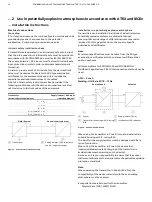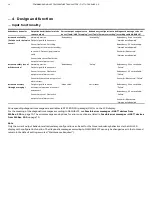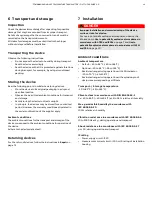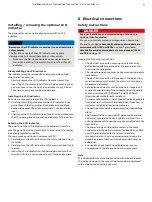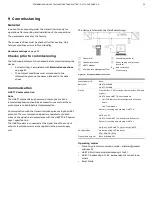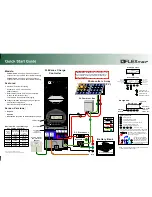
TTH300
HEAD-MOUNT TEMPERATURE TRANSMITTER | OI/TTH300-EN REV. G
21
Installing / removing the optional LCD
indicator
The transmitter can be optionally equipped with an LCD
indicator.
NOTICE
Damage to the LCD indicator caused by incorrect installation
/ disassembly
The flat ribbon cable of the LCD indicator can become
damaged due to incorrect installation / disassembly.
• Make sure the flat ribbon cable does not get twisted or
torn when installing / disassembling or rotating the LCD
indicator.
Disassembling the LCD indicator
The indicator must be removed to enable connection of the
sensor line or supply line:
Carefully remove the LCD indicator from the transmitter
inset. The LCD indicator is held firmly in place, meaning that
you may have to use the tip of a screwdriver to pry it loose.
Take care to avoid any mechanical damage.
Installing the LCD indicator
No tools are required to install the LCD indicator.
1.
Carefully insert the guide pins for the LCD indicator in the
guide holes of the transmitter inset. Make sure the black
connection socket fits into the terminal on the transmitter
inset.
2.
Then press the LCD indicator in as far as it will go. Make sure
that the guide pins and connection socket are fully inserted.
Rotating the LCD indicator
The position of the LCD indicator can be adjusted to suit the
mounting position of the transmitter, to ensure that the display
is as clearly legible as possible.
There are twelve positions at increments of 30°.
1.
Carefully turn the LCD indicator to the left to release it from
its holder.
2.
Carefully turn the LCD indicator until the required position is
reached.
3.
Insert the LCD indicator into its holder again and turn it to
the right into the required position until it snaps into place.
8
Electrical connections
Safety instructions
DANGER
Improper installation and commissioning of the device
carries a risk of explosion.
For use in potentially explosive atmospheres, observe the
information in
Use in potentially explosive atmospheres in
accordance with ATEX and IECEx
on page 7 and
Use in
potentially explosive atmospheres in accordance with FM
and CSA
on page 13!
Observe the following instructions:
• The electrical connection may only be established by
authorized specialist personnel and in accordance with
the connection diagrams.
• The relevant regulations must be observed during electric
installation.
• The electrical connection information in the instruction
must be observed; otherwise, the electric IP rating may
be adversely affected.
• Safe isolation of electric circuits which are dangerous if
touched is ensured only if the connected devices satisfy
the requirements of DIN EN 61140 (VDE 0140 Part 1)
(basic requirements for safe isolation).
• To ensure safe isolation, install connection leads separate
from electric circuits which are dangerous if touched, or
implement additional insulation measures.
• Connections must only be established in a dead-voltage
state!
• The transmitter has no switch-off elements. Therefore,
overcurrent protective devices, lightning protection, or
voltage disconnection options must be provided with the
installation.
• The power supply and signal are routed in the same
conductor and should be implemented as a SELV or PELV
circuit in accordance with the relevant standard
(standard version). For the explosion-proof design, the
guidelines in accordance with the Ex standard must be
adhered to.
• You need to check that the available power supply
corresponds to the information on the name plate.
Note
The signal cable wires must be provided with wire end sleeves.
The slotted screws of the connection terminals are tightened
with a size 1 screwdriver (3.5 or 4 mm).




